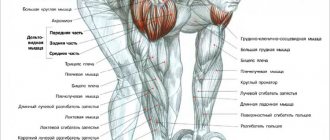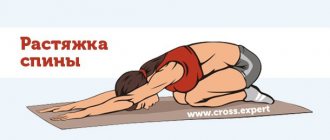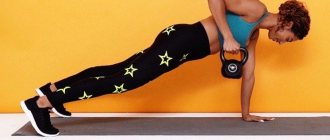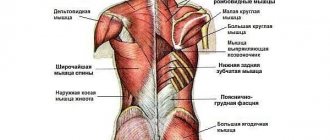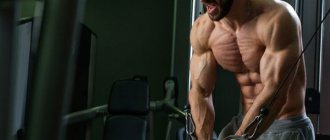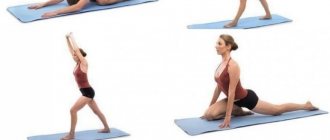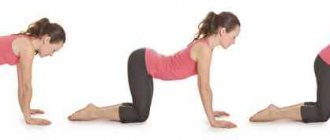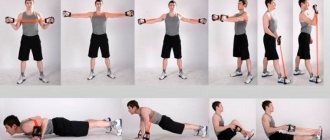One of the most important conditions for a healthy and attractive figure is the back muscles - they can and should also be trained at home.
A man who attracts a woman's gaze stands out in any crowd primarily because of his silhouette. Broad shoulders and a characteristic v-shaped torso will not allow such a person to get lost even among other athletic and trained men.
For women, a strong back is also an important component of a good figure, but more importantly, the development of back muscles helps a woman be healthier and more resilient.
Which back muscles are responsible for a beautiful silhouette?
The main largest muscles that create an attractive male figure are the trapezius, latissimus dorsi and spinal extensors. Other muscles also influence the silhouette - rhomboids, rotator cuffs, etc., but they are either located internally, under larger muscles, or relate more to other parts of the figure than the back.
So, to get a beautiful, sculpted back, training should be aimed at developing the trapezius, lats and back extensors.
- The trapezius dorsi muscles are located in the upper part of the back, towards the middle. Their bases are attached to the spine from the neck to approximately the middle of the back, and the tops are attached to the shoulder blade. These muscles bring the shoulder blades together, raise and lower them, and also allow you to tilt your head.
- The latissimus dorsi muscles are the same “wings” - they are also attached at the base to the spinal column, at the top of the back going under the trapezius, and at the top in a converging bundle to the inside of the top of the humerus. They pull the shoulders towards the body.
- Back extensors - straighten the spine. They run along the entire spinal column, providing extension of the back, or tilt in any direction. These muscles play a vital role in maintaining correct posture.
Why do you need strong back muscles?
The condition of the spine affects the health of the entire body. When the vertebrae are displaced, blood circulation and the supply of nutrients to cells are disrupted. Impaired blood circulation leads to fatigue, memory loss, drowsiness, and headaches. A crooked posture deforms the chest and compresses the stomach, which has serious consequences. Over time, arrhythmia and tachycardia can lead to coronary heart disease, and displacement of the abdominal organs can lead to prolapse of the kidneys and diseases of the genitourinary system.
Strengthening your back muscles will help prevent vertebral displacement. A strong back means minimizing injuries and ensuring good health. If the muscles are toned, a person can lift weights and withstand additional physical activity. The risk of diseases of the musculoskeletal system, including the occurrence of hernia and the development of osteochondrosis, is significantly reduced. Don't forget about another important aspect. Beauty comes as a bonus to health - correct posture transforms a person.
Causes of back problems
People who lead a sedentary lifestyle are at risk. Lack of physical activity leads to weakening of the muscles throughout the body, including the back. Moreover, sitting at a computer for a long time, a person ceases to control the position of his body. Many people spend working hours in a contorted position. The result is incorrect posture, back and neck pain. A busy schedule does not allow you to make time for going to the gym. The good news is that this is not necessary. We tell you how to strengthen your back muscles at home.
Is it possible to pump up your back without going to the gym?
For those who do not have the opportunity to visit the gym, you can exercise at home. To train your back muscles at home, you don’t even need special equipment. You can do pull-ups on the door; there are also bars and parallel bars in any yard; instead of dumbbells, you can use plastic bottles of water. And digging up a garden at the dacha or chopping wood for a bathhouse, according to experts, are among the top best exercises for developing back muscles.
Seriously speaking, for the entry level you don’t need any equipment at all. For the advanced, you will need dumbbells (collapsible) and preferably a horizontal bar. Almost all exercises with weights can be performed without a barbell - with dumbbells. And only professional-level athletes need a barbell, which allows them to give their back muscles a much greater load than dumbbells. However, you can also install a barbell at home.
Lower back muscles: location and structure
If we consider the structure of the muscles of the lower back, then first of all we should highlight the outer layer. This includes:
- latissimus muscle (lower part);
- thoracolumbar fascia.
However, deep muscles play a much larger role in the health of the area:
- Iliocostal muscle.
- Intertransverse muscles.
- Rotator muscles.
- Multifidus muscle.
All of them form the muscular corset of the lower back and are responsible for the functionality and health of the area.
Back workout at home
A set of special exercises will help avoid health problems caused by weakening back muscles. To start training your back at home, you need to prepare sports equipment. To begin with, a rug will be enough. What you should pay attention to when choosing:
- The rug should be dense enough so that you do not feel the hard surface of the floor when lying on your back.
- Size matters. The larger the area, the more convenient it is to practice.
- Anti-slip coating on both sides is required.
- An elastic, wear-resistant material without strong odors is suitable.
We have been strengthening our back muscles at home for several weeks. As you master new exercises, one gymnastic mat will not be enough. Over time, dumbbells and fitballs will come in handy. If you have free space in the house, it would be a good idea to install sports equipment or a back muscle trainer. A horizontal bar and a Roman bench are excellent tools for practicing.
The degree of load depends on the level of preparedness
The choice of exercises depends primarily on the level of preparedness. And for a fairly experienced athlete - from the need to load certain muscles.
- For a beginner who has never exercised before, it is better to start with muscle and ligament strengthening exercises, such as “good morning”, plank, pump, etc.
- More trained athletes will benefit greatly from exercises such as pull-ups, deadlifts, bent-over barbell rows, hyperextensions, etc.
- And finally, the most advanced athletes with well-developed muscles choose, depending on the goal, basic exercises with heavy weights or isolating exercises - pull-down (or sideways), rowing (on a machine), shrugs, etc.
Purpose of training
Much here depends not only on the level of training, but also on age, state of health, and also on the goal. Because some people want to acquire beautiful muscles to show off on the beach, others want to lose excess weight, and others want to strengthen their back muscles to correct their posture or to prevent back pain. Of course, in all these cases, a different training strategy can be chosen and different exercises can be selected for an individual training program.
For example, exercises that generally strengthen and develop the back extensors, such as planks and hyperextensions, are well suited for strengthening the back muscles for health purposes. To build a beautiful, impressive silhouette - exercises for the latissimus muscles, for example, dumbbell rows. Well, to preserve muscles while losing weight - basic exercises (deadlifts, squats and pull-ups).
Important components of training
- Warm up thoroughly to warm up your muscles. Many exercises for developing back muscles are considered traumatic. But poorly warmed muscles are one of the main (along with violations of correct technique) causes of injuries. After the main warm-up, and before moving on to the main exercises with weights, perform 2 warm-up sets with half the working weight.
- In most exercises for the back muscles, almost all the upper muscles (and not only the upper) are involved in the work. Therefore, it is important to focus the load on target muscle groups. For example, in pulling exercises, try to squeeze your shoulder blades together first and only then bend your elbows. Try, as far as possible, to turn off the biceps and other muscles of the arms and shoulders, using the back muscles as much as possible.
- Changing the grip width makes it possible to shift the emphasis to different muscles - try to choose in each exercise the type and width of grip that is comfortable for you and in which your target back muscles work as much as possible.
- Don't neglect stretching, trying to do it after every back muscle workout. With constant stress and stress, muscles become overstrained, shortened and damaged, creating the risk of injury and distorting posture.
Entry-level back exercises
It is better to start with the basics that do not require physical training. At first, it is better to avoid sudden movements, heavy loads and weight-bearing exercises.
Basic home exercises for back muscles:
"Kitty"
Get on all fours. Keep your arms straight, place your hands under your shoulders, your back parallel to the floor, your head looking down. Arch your back upward and press your chin to your chest, stay in this position for 5-7 seconds, then slowly return to the starting position.
"Plank"
It is necessary to take a horizontal position, leaning on your elbows and toes. The entire body should be elongated in one line. The arms are bent at the elbows at 90 degrees. The face looks down, or slightly forward. The abs are tense. You can start with a routine of 15 seconds in the plank, 30 seconds of rest and 3-4 repetitions. Gradually increasing the time of performing the exercise from 15 seconds to 60 or more. The exercise must be performed 2-3 times a day. It strengthens all the core muscles, including the abs.
"Rear Axle"
Lying on your back, bend your knees at an angle of 90-120 degrees and, supported by your heels and shoulders, slowly lift your pelvis up and hold the position for 10 seconds, rest for the same amount of time.
"Side plank"
Performed lying on your side, legs bent at the knees at an angle of 90 degrees, hips and torso forming a straight line, supported by the forearm and knee, lift the pelvis and hold for 10 seconds, then rest for 10 seconds.
"Boat"
We lie on the floor on our stomach, stretch our arms forward. Then, straining the back muscles, we raise our arms and legs up above the floor so that the body from the side looks like a boat. We hold this position for 10 seconds, then rest for 10 seconds. You can start with 5-6 repetitions, gradually increasing the number of repetitions and time from 10 to 30 seconds.
More complex exercises
When the basic exercises begin to be easy, it’s time to move on to more complex ones. Strength training with weights is especially effective. You will need dumbbells or weights.
Exercises for back muscles at home with weights:
Deadlift
Starting position – standing, back straight, shoulders down, abs tense. Dumbbells touch your thighs. With your knees bent, move your pelvis back until your back is parallel to the floor. The dumbbells move down the legs. The back should remain straight; a strong deflection is dangerous. To avoid injury, the weight of dumbbells for beginners should be light.
Bent over arms raise
Place your feet shoulder-width apart, knees bent, and body slightly tilted forward. With your arms bent at the elbows and holding dumbbells, spread them out to the sides until your upper arms are parallel to the floor. Hold the position for a couple of seconds and bring your hands back together.
Bending your arms back
Take the starting position - feet shoulder-width apart, knees bent and body slightly tilted forward. Move your straight arms with dumbbells as far back as possible. The back muscles should be tense and the body motionless.
Hyperextension
You will need a Roman bench to perform this exercise, although in some cases you can use a sofa. The main thing here is that the legs in the feet are well secured with something. The edge of the bench should be level with your upper thighs. In the initial position, the body is lowered down towards the floor. As you inhale, straighten your back and straighten your hip joints, lifting your body up so that your body forms a straight line. Hold this position for 2 seconds and lower to the starting position. You can start with 10-12 repetitions (to the best of your ability), gradually increasing their number and number of approaches.
Back stretching exercises
If your muscles hurt after strength training, it means you did a good job. But sometimes severe muscle pain indicates insufficient warming up before training. How to start and finish a lesson correctly? There are such concepts as warm-up and cool-down. To avoid injury and prepare your body for the stress of exercise, you should spend the first five to ten minutes stretching. Exercises to warm up your back muscles:
Mill
The legs are spread wider than the shoulders, arms are spread to the sides. Bend your back until it is parallel to the floor and, without bending your arms, touch your feet one at a time. The right hand reaches for the left leg, and the left hand for the right.
Side bends
Hands on the waist, feet shoulder-width apart. Tilt to the left, right hand reaches behind the body, then take the starting position and similarly tilt to the right.
Cool-downs are simple exercises at the end of a workout. They ensure a smooth transition of the body from a tense to a calm state. Must be completed immediately after finishing the main lesson. Static exercises on a mat, with a chair or an elastic band are suitable. Usually, about ten minutes are allotted for a cool-down, but if time is really short, you can get by with five. You should not stretch through the pain or jerkily, it is important that the sensations be comfortable. The massage roller will finally relax the muscles; it is recommended to use it at the end of the session.
Pull-ups
Starting position: Grasp the bar with your palms facing your chest, keeping the handle close to your shoulders. Straight back and curved lumbar region with a slight protrusion of the chest forward.
- Execution: Exhale and rise up until your head reaches the height of the bar. At this moment, inhale and return your body to its original position.
- How many times to repeat: The number of repetitions you need to perform depends on your form, so it is recommended to start by trying to perform as many stretches as possible, setting a fatigue limit, and then gradually increase the number of repetitions of the movement over time.
Back workout for girls
Women's back muscle structure is exactly the same as men's, so they can do exactly the same exercises for their back muscles. You just need to take into account your level of training and use lighter weights. Women who only want to strengthen their back, and not develop relief, can generally stop at entry-level exercises - plank, pump, exercises on a fitball, etc. If you want to develop your back even more, then hyperextensions, bent-over dumbbell rows, dumbbell bend-overs, etc. are mandatory. Developed back muscles make it possible to more effectively develop the muscles of the legs and buttocks, making the waist visually narrower and the figure more harmonious and attractive.
Exercise #1: Standing Hamstring Stretch
Place one foot on a low stool or stand - any object no more than 15 cm high that you can lean on will do. Focus on the heel, toe slightly towards you. Begin to slowly lean toward your straight leg until you feel tension in the back of your thigh. Stay in this position for 15-30 seconds and change legs. When bending, you need to make sure that the leg you are leaning towards is straight, there is no arching in the lower back, and your shoulders are not slouched. Repeat this three times on each leg.
You can exercise without a stand. One leg is slightly bent, the other rests its heel on the floor, toes pointing towards itself, the knee is not bent. You should reach towards the toe of your straightened leg. If possible, grab the toe with your hands. Another option: do the same, but rest your hands on your straightened knee. Lean forward slightly until you feel a stretch in the back of your thigh. And watch your shoulders and lower back!
Men's back workout
Exercises that develop back muscles are mandatory for men. Most men develop back problems with age - osteochondrosis, sciatica, etc. Their likelihood can be greatly reduced if you start exercising and strengthening your back muscles as early as possible. For those who have not exercised for many years, entry-level exercises – without weights – are a must. Next, exercises are required that develop the latissimus dorsi muscles and back extensors - deadlifts, bent over raises with dumbbells, hyperextensions (including with weights), pull-ups. Be sure to complement your back training with exercises to develop the abs and lateral abdominal muscles, shoulder girdle and chest, as well as legs. A lagging back will not allow you to build powerful biceps and quadriceps. To avoid distortions and to ensure your back never hurts, you need to pay great attention to training your back muscles.
It is possible to strengthen your back muscles at home. To do this, you don’t have to buy expensive sports equipment and spend hours training. Enough regular exercise on the mat, and later with dumbbells, and the muscles will gradually become stronger. Back problems will forever remain a thing of the past, you just have to accustom yourself to regular exercise. The tips from the article will make your training as effective as possible and reduce the risk of injury to a minimum. And if you also want to lose excess weight (which will also have a beneficial effect on your back), you can try buying a fat burner and BCAA.
Remember that the main thing in creating a beautiful body is to work out systematically, trying different training programs, not to relax and not to give up. Despite the fact that developing muscles and getting rid of excess fat takes considerable time. Visually noticeable changes in the figure will appear after a month, but to form a truly athletic figure it may take more than a year (or even 2-3, depending on the degree of neglect of the situation, the existing constitution, age, health and other factors). It is also important to make your diet rational, constantly count calories, monitor the ratio of dietary fat, and give up bad habits and unhealthy snacks.
In order to better balance your diet, nourish the body with healthy fats and vitamins, support muscles and joints during training, and prevent a decline in immunity, you can use various supplements from the sports nutrition arsenal, for example, BCAA, omega-3 or joint products.
Exercises with non-standard equipment
If you have a chest expander, fitball or rubber band (rubber loop) on hand, choose the appropriate one from the exercises presented. They will significantly diversify your load and allow you to work your muscles at a more natural angle. Suitable for both home and hall.
- Reduction of shoulder blades with a chest expander. A unique exercise that simultaneously works the rhomboid and latissimus dorsi muscles. It is considered one of the heaviest. It has the maximum natural amplitude for a person.
- Pull your own weight using a rubber band. A lightweight version of pull-ups and a complete analogue of the overhead pull-down.
- Horizontal pull-ups with a tourniquet. Analogous to the thrust of a horizontal block. One side of the tourniquet is tied to the battery (door handle, etc.), the further task is to sit on the floor and pull your body towards the projectile, completely raising your body and without bending your legs at the knee joint.
- Hyperextension on a fitball.
Recipes for healthy eating
Oatmeal pancake - the simplest diet pancake recipe
- 4.37 Proteins
- 10.7 Fats
- 28.2 Carbohydrates
- 256 kcal
20-25 min.
- #dietary
- #breakfast
- #milk
- #low calorie
- #cereals
- #vegetable oil
- #egg
Other recipes
Why pump up your lower back?
The main reasons for the development and pumping of the lower back:
- Prevention of protrusions and hernias.
- Development of flexibility.
- Training the functionality and endurance of muscles, the ability to maintain vertical and horizontal body positions for a long time.
- Eliminates the "weak link" in most basic movements.
- Preventing compression load on the spine in any exercises with axial load.
- Balanced development of all back muscles (imbalance can cause serious negative consequences for the health of internal organs, spine, posture, and so on).
In general, the muscles in the back of the lower back play a key role in both sports and everyday life for every person. It is this area that largely determines the health of the spine and mobility, especially in adulthood. Therefore, the lower back should become the main object for pumping for every person.
Recommendations
Don't train your lower back too often. For prevention and stable development, it is enough to do this once a week. In case of problems, if you urgently need to pump up an area, it is allowed to introduce 2-3 classes per week into the training regimen. But at the same time, only one workout should be with weights, the rest should be toning or supporting (you can even do it at home).
In general, it is enough to do 2-3 exercises per area per workout. For example, if you do deadlifts and hyperextensions, this will already create enough tension for muscle development. In this case, it would be a good idea to add a few sets of static movements to work the deep muscles. The standard number of repetitions for sets with weights is 8-10.
